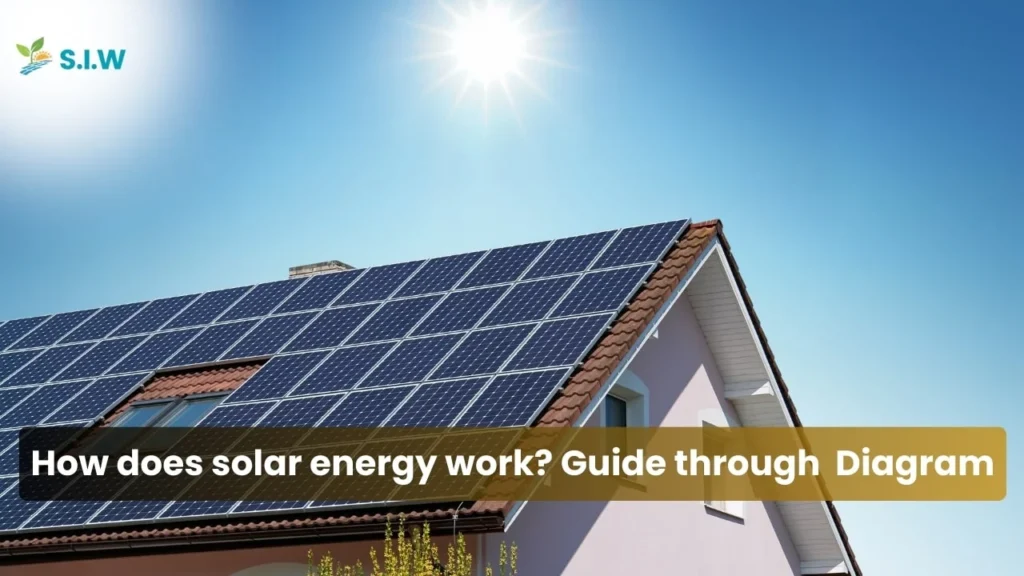Solar energy is a fascinating and sustainable source of power. It starts with sunlight, which is harnessed and transformed into electricity. In this blog, we’ll break down how solar energy works in a step-by-step manner, ensuring that even a kid can understand the entire process from sunlight hitting the solar panels to powering your home.
Diagram of Solar Energy Process:
mathematical
Copy code
Sunlight → Solar Panels → Inverter → Electrical Panel → Home Appliances
Explanation of the Diagram:
| Step | Process | Details |
| 1. Sunlight | The energy source for solar panels. | Sunlight is composed of photons that carry energy. |
| 2. Solar Panels | Capture sunlight and convert it to direct current (DC) electricity. | Made of photovoltaic cells that convert solar energy. |
| 3. Inverter | Converts DC electricity to alternating current (AC) electricity. | Essential for compatibility with home appliances. |
| 4. Electrical Panel | Distributes electricity to the home. | Connects to various circuits for lights and appliances. |
| 5. Home Appliances | Use electricity for everyday tasks. | Powers devices like refrigerators, lights, and computers. |
Step 1: Capturing Sunlight
Solar panels, typically made of silicon cells, capture sunlight. These cells contain electrons that become energized when exposed to sunlight, creating an electric current.
Personal Experience: When I installed my home solar system, I was amazed at how efficiently it transformed sunlight into energy. On sunny days, it felt rewarding to watch the meters show energy production.
Step 2: Conversion of Energy
The electricity generated by solar panels is initially in the form of direct current (DC). However, most of our home appliances run on alternating current (AC). This is where the inverter plays a critical role.
Step 3: Role of the Inverter
The inverter converts the DC electricity from the solar panels into AC electricity, making it suitable for household use. This step is essential for ensuring that the electricity can effectively power everything in your home, from lights to appliances.
Step 4: Distribution of Power
Once the AC electricity is generated, it flows into your electrical panel. From there, it is distributed throughout your home, providing energy to various appliances and devices.
Benefits of Solar Energy:
- Cost Savings: Reduces electricity bills significantly.
- Environmentally Friendly: Decreases your carbon footprint.
- Energy Independence: Reduces reliance on traditional energy sources.
Step 5: Monitoring and Maintenance
To ensure optimal performance, regular monitoring of the solar energy system is crucial. Many systems come equipped with monitoring tools that allow you to track energy production and usage.
Personal Experience: After installing the monitoring app, I could easily see how much energy we produced daily. This helped my family become more energy-conscious, leading to even greater savings on our electricity bills.
Common Misconceptions About Solar Energy
Many people believe that solar energy only works in sunny areas or that it’s too expensive to install. The truth is that solar panels can generate energy even on cloudy days, and various financial incentives make installations more affordable than expected.
Choosing the Right Solar System
When considering solar energy, it’s crucial to evaluate your needs. Here are some factors to consider:
- Energy Consumption: Assess your monthly energy usage to determine the size of the solar system you need.
- Roof Space: Ensure you have enough space for the number of panels required.
- Budget: Factor in installation costs and potential savings over time.
Exploring Solar Battery Storage
For those considering a commercial solar battery storage solution, it’s important to understand how battery systems work with solar panels. These batteries store excess energy generated during the day, allowing you to use it when sunlight is not available. This increases your energy independence and helps reduce reliance on the grid.
| Battery Type | Usage | Benefits |
| Lithium-Ion | Common for home solar systems | Longer lifespan and higher efficiency |
| Lead-Acid | Traditional option for energy storage | Lower upfront cost, but shorter lifespan |
| Flow Batteries | Emerging technology for large-scale storage | Suitable for commercial solar applications |
Conclusion: Embracing Solar Energy
Solar energy is a powerful solution for reducing energy costs and protecting the environment. By understanding how solar energy works, you can make informed decisions about harnessing this renewable resource for your home.
FAQs
- How do solar panels work? Solar panels capture sunlight and convert it into electricity using photovoltaic cells, generating direct current (DC) electricity.
- What is an inverter in solar energy systems? An inverter converts the direct current (DC) electricity produced by solar panels into alternating current (AC) electricity, which is used in homes.
- Can solar panels work on cloudy days? Yes, solar panels can still generate electricity on cloudy days, though at a reduced efficiency compared to sunny days.
- Are solar panels expensive to install? While the initial installation cost can be high, many financial incentives and long-term savings on energy bills make solar systems more affordable.
- How does battery storage work with solar panels? Solar battery storage systems store excess energy generated during the day, allowing you to use that energy at night or during cloudy periods.








